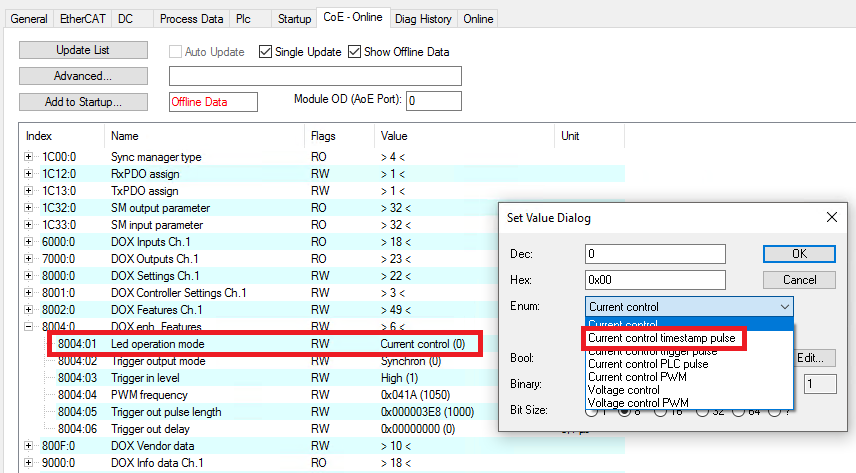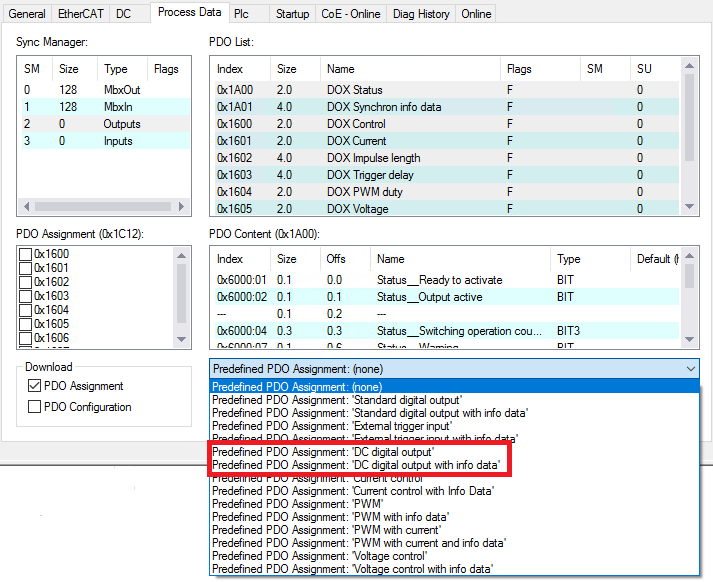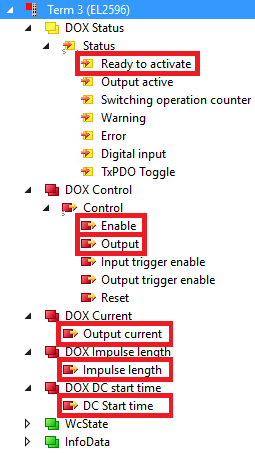Current control timestamp pulse
In pulse mode, the maximum current amplitude is 3 A with 12 V LEDs. It is possible to output a pulse in each cycle. The specified parameters for the current intensity and pulse duration are transmitted with each new specified start time. The data can be transmitted at the same time as the start time, so that a new pulse output with different parameters is possible in each cycle.
For all pulsed operating modes (current control timestamp pulse, current control trigger pulse, current control PLC pulse) the maximum constant duty cycle as a function of the output current must be considered.
- Iout = 1 A: 20% duty cycle
- Iout = 2 A: 10% Duty Cycle
- Iout = 3 A: 8% Duty Cycle
In this operation mode, it is possible to configure the trigger input as an enable input so that it can be used as an external switch. An output can then only be actuated with a specified signal at the trigger input. If the trigger input is active, a pulse with the specified parameters is output when the specified DC start time is reached. More detailed information and commissioning can be found in the chapter Hardware enable.
Especially in the current controlled pulse operation modes the use of the automatic determination of the output voltage is recommended, because possibly for the generation of high current pulses at the output a high pre-voltage is needed to generate steep edges. These may be higher than voltages specified in the LED data sheet.
If the supply voltage is removed during operation in the pulsing modes, there will be a malfunction at the output. In addition, an overcurrent may occur at the LED output. Therefore, a stable voltage supply must be ensured. To minimize the risk of malfunction and overcurrent, the enable bit can be set together with the output bit so that the enable is not permanently set.
To set the LED output as a distributed clock controlled pulse output, make the following settings:
- Nominal/limit current of the LED in the unit mA in the CoE parameter 0x8000:02 “Target current”
- Input voltage in the unit 0.01 V in the CoE parameter 0x8000:03 “Supply voltage”
- Desired output voltage in the unit 0.01 V (max. UIN - 2 V) in the CoE parameter 0x8000:04 “Output voltage”.
- If currents are to be output above the nominal current of the LED, a higher specification is necessary for the output voltage in the CoE parameter 0x8000:04 due to the non-linear behavior of LEDs and the current control capability of the circuit.
- In this operation mode, the value set here corresponds to the output on the controller. If the forward voltage of the connected LED is lower than the value set here, the remaining voltage drops internally in the EL2596. In many cases, this leads to overtemperature in the terminal and thus to the switching off of the LED output. As the desired output voltage, therefore, the forward voltage at the desired output current should be set here. The TeachIn function can also be used to determine the output voltage.
- Set the operation mode in the CoE directory in the CoE parameter 0x8004:01 to “Current Control timestamp pulse”
- In “Predefined PDO assignments”, select “DC digital output (with info data)”
- On the “DC” tab, select the operation mode “DC active (Controller handled)”
- Specify the set current in the unit mA via “DOX Current” → “Output Current”
- Specify the pulse length in the unit µs via “DOX Impulse length” → “Impulse length”. The resolution of the time can be reduced from 1 µs to 100 ns using the CoE parameter 0x8002:31 “Pulse resolution 100 ns”.
- Specify the start time of the pulse via “DOX DC Start time” → “DC Start time”.
A new start time may only be specified once the current start time + the specified pulse length has elapsed. - Check under “DOX Status” → “Status” whether the “Ready to activate” bit is 1.
- Activate the control under “DOX Control” → “Control” via the “Enable” bit.
- Switch on the LED output under “DOX Control” → “Control” by activating the “Output” bit.
 Fig.153: Operation mode setting “Current Control timestamp pulse”
Fig.153: Operation mode setting “Current Control timestamp pulse” Fig.154: PDO setting “DC digital output (with info data)”
Fig.154: PDO setting “DC digital output (with info data)” Fig.155: Activating the Distributed Clocks
Fig.155: Activating the Distributed Clocks Fig.156: Activate the output in the operation mode “Current control timestamp pulse”
Fig.156: Activate the output in the operation mode “Current control timestamp pulse”